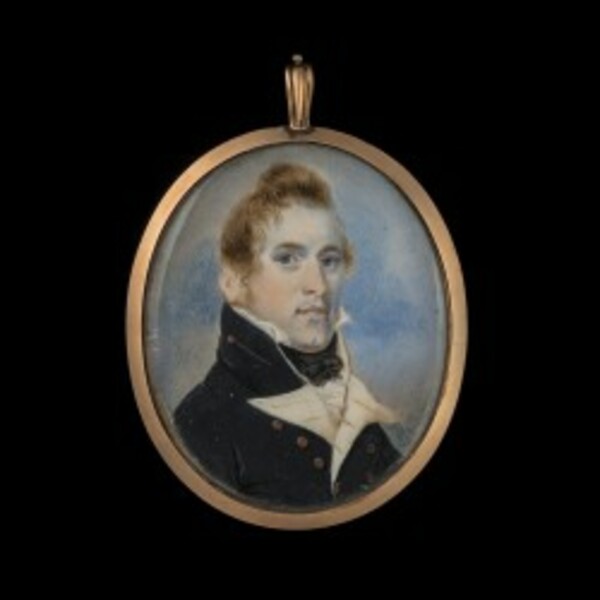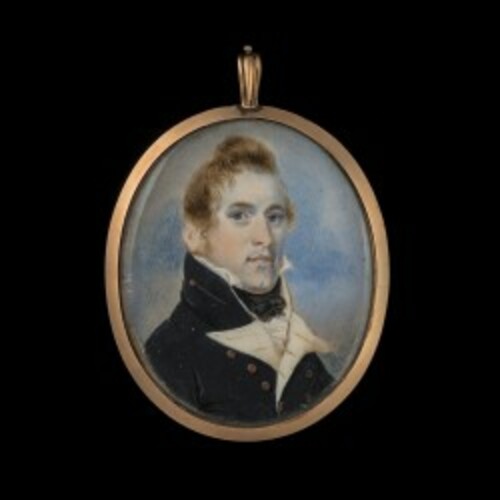
Source: Link
PRING, DANIEL, naval officer; b. c. 1788 at Ivedon Penn, near Honiton, England; m. 27 Aug. 1810 Anne ———; they apparently had no children; d. 29 Nov. 1846 in Kingston Harbour, Jamaica.
Daniel Pring entered the Royal Navy as a midshipman on 13 Feb. 1800, and after exceptional performance as a midshipman, master’s mate, and acting lieutenant, he was given command in January 1808 of the 12-gun schooner Paz, captured the year before in an attack on Montevideo (Uruguay). Confirmed in rank on 12 May 1808, Pring had a highly successful commission with this vessel, in European waters and on the North American station. In September 1811 he joined the Africa (64 guns), flagship of Rear-Admiral Herbert Sawyer at Halifax. Twelve months later he went to Sir John Borlase Warren*’s flagship, the San Domingo (74 guns), and on 5 March 1813 he was sent, with Lieutenant Robert Heriot Barclay and several other officers, to command vessels on the lakes of Canada.
On 5 May Pring took charge of the Royal George (22 guns) on Lake Ontario, but when Captain Sir James Lucas Yeo*, the new senior naval officer in the Canadas, arrived ten days later, he gave Pring the Wolfe (20 guns). On 17 July Yeo selected him to organize the dockyard and naval establishment at Île aux Noix, in the Rivière Richelieu, and to assume command on Lake Champlain. Pring was confirmed in the rank of commander on 13 Nov. 1813.
Yeo’s choice was a fortunate one; Pring’s energetic and imaginative support of the army resulted in a series of raids and defensive measures that kept American forces off balance for the better part of a year. Pring was instrumental in the destruction of naval and military installations at Plattsburgh, N.Y., in August 1813 and at Cumberland Head, N.Y., in December. In January 1814 he supervised the construction of gunboats at Coteau-du-Lac to defend Montreal against possible attack from the west, and on 30 March he gave supporting fire from sloops and gunboats to help defend the blockhouse in the Rivière Lacolle.
Pring could not, with the forces at his disposal, prevent the buildup on Lake Champlain of a strong and efficient American naval force under an exceptional officer, Thomas Macdonough, and on his recommendation two new vessels, the 16-gun brig Linnet and the 37-gun ship Confiance, were constructed. In September 1814 Yeo’s new second in command, Captain George Downie, took over Confiance and the squadron on Lake Champlain.
Preparations for a British offensive on the western shore of Lake Champlain were then in their final stages. The Confiance was not ready when the army under Sir George Prevost* began its advance, so on 3 September Pring sailed in Linnet, accompanied by 11 gunboats, to protect the army’s left flank. Five days later he was joined by the Confiance, still short of equipment, and the sloops Chubb and Finch. At dawn on 11 September – the men of the Confiance “unacquainted with each other and with their Officers, . . . in a Ship which had been sixteen days before, on the Stocks” – Downie led his flotilla into action. The vessels sighted the American ships and gunboats anchored in Plattsburgh Bay at seven and began firing at eight. By a quarter to eleven Downie had been killed, Confiance had struck her colours, and Pring had surrendered the remaining vessels to Macdonough.
This defeat was the subject of intense mutual recrimination between the army and the navy, but Pring and several other officers were judged by a naval court martial to have “conducted themselves with great Zeal Bravery and Ability.” Promoted post-captain on 19 Sept. 1815, in June 1816 he received an appointment to command the naval establishment on Lake Erie at the mouth of the Grand River. Retrenchment brought this appointment to an end before the summer of 1817 was out, and Pring went on half pay for nearly 20 years. On 1 Dec. 1836 he received command of the Inconstant (36 guns); in 1838 he brought Lord Durham [Lambton] home from Quebec in this vessel. On 28 July 1841 he took charge of the Thunderer (84 guns). That ship paid off in December 1843, and Pring was placed on half pay until 16 Sept. 1845, when he was given the Imaum (76 guns), with the rank of commodore, and became senior naval officer at Jamaica. Late in 1846, yellow fever spread among the ships at Jamaica; news eventually reached Devon that Pring had succumbed during the epidemic. The inscription on his tombstone in Kingston states that he “fell victim to the climate at Port Royal while filling the post of commodore of the Jamaica station.”
Neither Pring nor his contemporaries were forthcoming about his private affairs. He spent his first years, and his years on half pay, at his Devon home, Ivedon Penn. When he died he left a considerable amount of land to his widow and other property to a close friend in Tavistock. The fact remains that he played an indispensable part in protecting the Montreal frontier during the War of 1812.
[Secondary sources make few references to Pring; he played a marginal role in the War of 1812, in spite of the responsibility that was thrust upon him. To place his activities in context, standard histories of the War of 1812 should be consulted. The best bibliography is Free trade and sailors’ rights: a bibliography of the War of 1812, comp. J. C. Fredriksen (Westport, Conn., and London, 1985). [E. B. Brenton], Some account of the public life of the late Lieutenant-General Sir George Prevost, bart., particularly of his services in the Canadas . . . (London, 1823), contests statements about the defeat at Plattsburgh made at Pring’s court martial but has little bearing on Pring himself, since it was Downie who was the object of controversy. A. T. Mahan, Sea power in its relations to the War of 1812 (2v., Boston, 1919), has yet to be superseded. Theodore Roosevelt, The naval war of 1812; or, the history of the United States Navy during the last war with Great Britain; to which is appended an account of the battle of New Orleans (2v., Philadelphia, 1902), is still quite durable. w.a.b.d.]
NMM, C. G. Pitcairn-Jones, notes on sea officers. PAC, RG 8, I (C ser.), 166, 230, 273, 679–83, 694, 730–32, 1203, 1219–21. PRO, ADM 1/2346–52 (mfm. at PAC); ADM 23/106; ADM 50/227; PROB 11/205. Select British docs. of War of 1812 (Wood). G.B., Admiralty, The commissioned sea officers of the Royal Navy, 1660–1815, [ed. D. B. Smith et al.] (3v., n.p., [1954]). Marshall, Royal naval biog. [Dwells entirely on Pring’s service on Lake Champlain. w.a.b.d.] W. R. O’Byrne, A naval biographical dictionary: comprising the life and services of every living officer in her majesty’s navy . . . (London, 1849).
Bibliography for the revised version:
Find a Grave, “Memorial no.119916961,” “Memorial no.187976221”: www.findagrave.com (consulted 6 March 2019).
Cite This Article
W. A. B. Douglas, “PRING, DANIEL,” in Dictionary of Canadian Biography, vol. 7, University of Toronto/Université Laval, 2003–, accessed January 5, 2026, https://www.biographi.ca/en/bio/pring_daniel_7E.html.
The citation above shows the format for footnotes and endnotes according to the Chicago manual of style (16th edition). Information to be used in other citation formats:
| Permalink: | https://www.biographi.ca/en/bio/pring_daniel_7E.html |
| Author of Article: | W. A. B. Douglas |
| Title of Article: | PRING, DANIEL |
| Publication Name: | Dictionary of Canadian Biography, vol. 7 |
| Publisher: | University of Toronto/Université Laval |
| Year of publication: | 1988 |
| Year of revision: | 2025 |
| Access Date: | January 5, 2026 |



